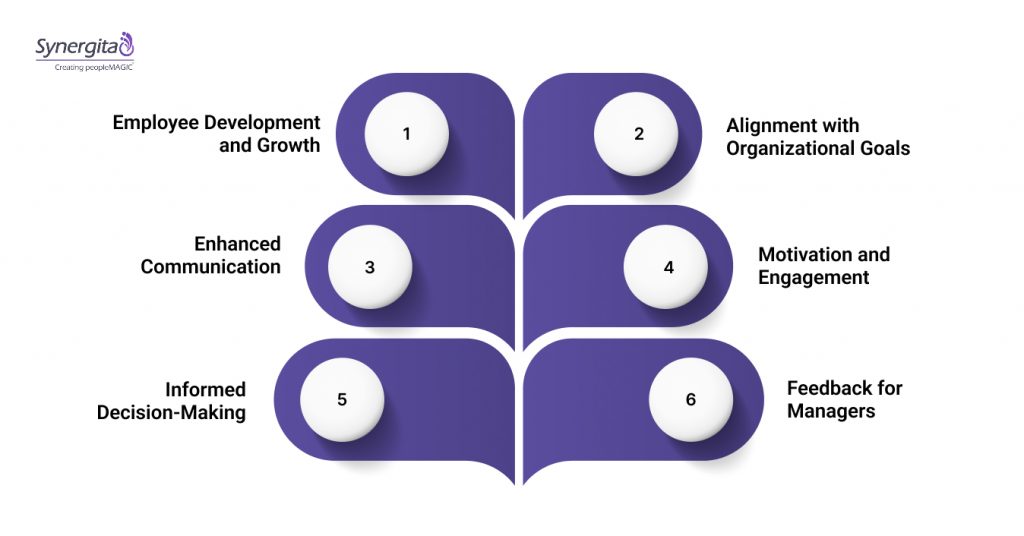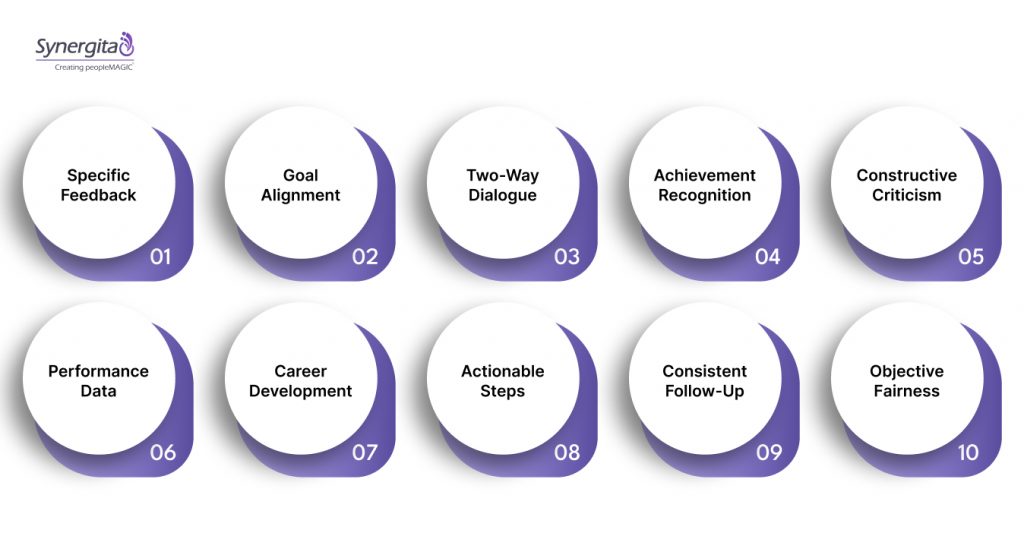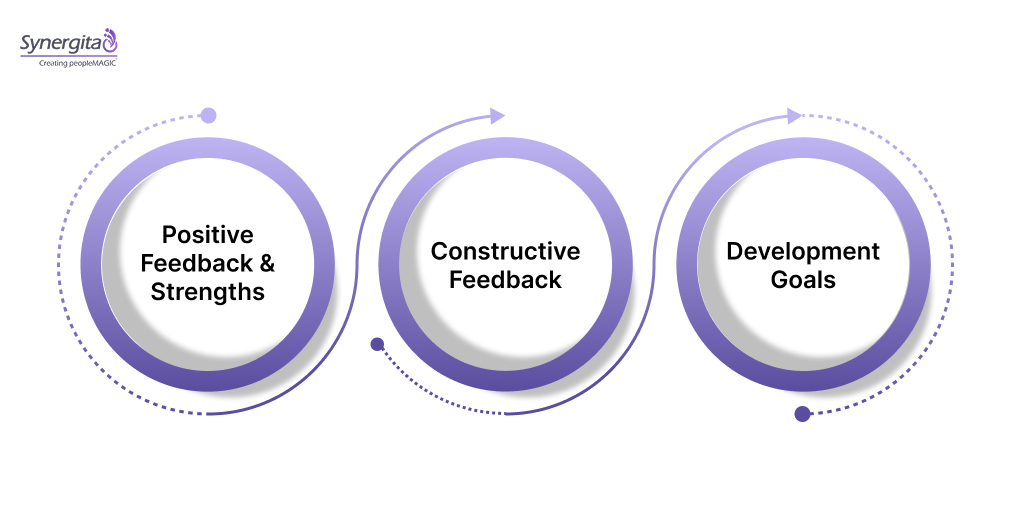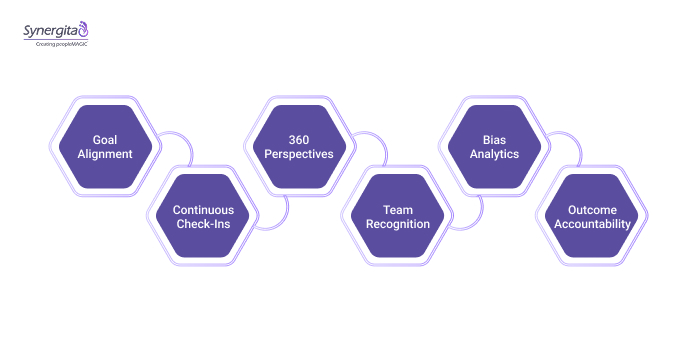An employee performance review is a two-way conversation that helps align individual performance with organizational goals.
A crucial aspect of employee development, performance reviews offer managers an opportunity to provide feedback, recognize achievements, and set goals for the future. However, the effectiveness of a performance review goes far beyond the meeting itself.
Gallup research indicates that only 2 in 10 employees (20%) feel that their performance is managed in a way that motivates them to do outstanding work. A mere 14% agree that performance reviews inspire them to improve their work.
To address this gap, organizations should focus on providing continuous feedback, setting clear goals, and maintaining open communication throughout the year. By fostering an ongoing dialogue and providing actionable insights, performance reviews can become a catalyst for sustained employee growth and engagement.
As a starting point, this article provides 10 essential tips on how to give an effective employee review.
At a Glance:
- Performance reviews are vital for evaluating employee performance, providing feedback, and setting goals for the future.
- They help in employee development, align individual and organizational goals, and boost motivation and engagement.
- Key elements of an effective review include clear and specific feedback, goal setting, two-way dialogue, and constructive criticism.
- After the review, follow up on the action plan, document the feedback, provide development opportunities, and maintain open communication for continuous improvement.
What Are Performance Reviews and Why Are They Important?

Performance reviews are formal assessments where managers evaluate an employee’s job performance, accomplishments, and areas for improvement over a specific period. Typically conducted annually, semi-annually, or quarterly, these reviews provide employees with feedback on how well they are meeting expectations, fulfilling their roles, and contributing to the organization’s objectives.
Why Are Performance Reviews Important? Let’s see:
1. Employee Development and Growth
Performance reviews offer employees valuable insights into their strengths and areas that require improvement. This feedback is essential for guiding their professional development and helping them improve their skills and performance. By identifying areas for growth, performance reviews help employees set clear goals for the future.
2. Alignment with Organizational Goals
Reviews allow managers to assess how well employees’ individual goals align with the overall objectives of the organization. This alignment ensures that employees are working toward common company goals, helping to drive business success.
3. Enhanced Communication
Regular performance reviews foster open communication between employees and managers. They provide an opportunity to discuss achievements, challenges, and any concerns. This two-way dialogue helps build trust and transparency within teams, improving overall collaboration.
4. Motivation and Engagement
When conducted properly, performance reviews can significantly boost employee morale and engagement. Recognition of achievements during reviews reinforces positive behaviors, encourages job satisfaction and employee retention, and motivates employees to maintain high levels of performance.
5. Informed Decision-Making
Performance reviews provide data that can help HR teams and managers make informed decisions regarding promotions, salary adjustments, career development opportunities, and even retention strategies. This ensures that decisions are based on objective evaluations rather than assumptions.
6. Feedback for Managers
Performance reviews also serve as a way for employees to provide feedback to managers, which helps identify areas where management can improve. This feedback loop creates a culture of continuous improvement, benefiting both employees and the organization.
Performance reviews are critical for individual employee growth, organizational alignment, improved communication, and overall business success.
Key Elements of an Effective Performance Review

An effective performance review goes beyond simply rating an employee’s work. It is a comprehensive process that fosters growth, enhances performance, and aligns individual contributions with organizational goals. Here are the key elements that make a performance review effective:
1. Clear and Specific Feedback
Feedback should be actionable, specific, and based on observable behaviors and outcomes, not general or subjective opinions. Instead of vague comments like “You need to improve,” provide concrete examples. For example: “Your report was well-organized and helped clarify complex data for the team.”
2. Goal Setting and Alignment
A strong performance review includes a discussion of both past achievements and future goals. It should align individual objectives with company-wide goals, ensuring that employees understand how their work contributes to the organization’s overall success. Setting SMART (Specific, Measurable, Achievable, Relevant, Time-bound) goals during the review ensures clear expectations for future performance.
3. Two-Way Dialogue
Encourage employees to share their thoughts, self-assessments, and feedback on team dynamics, company culture, and leadership. This open communication builds trust and provides valuable insights for improvement on both sides.
4. Recognition of Achievements
Acknowledging accomplishments is crucial for motivating employees and boosting morale. Highlight specific achievements, milestones, and positive contributions the employee has made during the review period. Recognition can be both personal and professional, reinforcing the value the employee brings to the team.
5. Constructive Criticism
Constructive feedback should focus on areas for growth rather than solely on what went wrong. Frame it in a way that encourages development, not defensiveness. For example, instead of criticizing the lack of communication, say, “I’ve noticed there were times when project updates weren’t as clear. In the future, we can use a more structured approach to ensure everyone is aligned.”
6. Performance Metrics and Data
Using objective, data-driven insights is key to providing unbiased evaluations. Incorporating measurable data—such as sales figures, productivity metrics, or project deadlines—ensures that the feedback is based on performance rather than subjective perception. This approach makes the review process more transparent and fair.
7. Focus on Career Development
An effective review should assess current performance and also focus on the employee’s career aspirations. Discuss opportunities for skill development, leadership training, or other growth paths within the organization. This helps the employee see the long-term benefits of continuous performance improvement.
8. Actionable Next Steps
Every performance review should include a plan of action, outlining the next steps for both the employee and the manager. Whether it’s skill development, new project responsibilities, or adjustments in work habits, setting clear, actionable goals ensures both parties are on the same page about expectations moving forward.
9. Consistent Follow-Up
An effective performance review is the beginning of an ongoing process. Schedule follow-up meetings or check-ins to discuss progress on goals, provide continued feedback, and address any challenges. This demonstrates the commitment to continuous development and helps ensure sustained improvement.
10. Fairness and Objectivity
Finally, ensure the review process is fair and objective. Avoid bias by basing feedback on clear performance indicators, measurable data, and observed behaviors rather than personal opinions or external factors. A fair review process boosts employee trust and engagement.
We have covered the key elements of an employee performance review. Now, let’s learn the essential tips for an effective review process.
10 Essential Tips for Effective Employee Performance Reviews
Conducting a performance review helps employees understand their strengths while keeping you in alignment with organizational goals. Here’s a step-by-step guide on how to conduct an effective employee performance review:
1. Prepare Ahead of Time
Proper preparation is crucial for a successful performance review. As a manager, gather all necessary information before the meeting:
- Review the Employee’s Self-Assessment: If your organization uses a self-assessment form, look at the employee’s reflections on their performance.
- Collect Performance Data: Gather metrics, feedback, and data from the review period, such as goals achieved, key performance indicators (KPIs), and project outcomes.
- Review Past Performance Reviews: Look at previous reviews to track progress on past goals and follow up on areas for improvement.
Tip: Set aside time to reflect on the employee’s performance, achievements, and challenges to provide a balanced and thoughtful review.
2. Create a Comfortable and Private Setting
Performance reviews should be conducted in a private, quiet space to ensure confidentiality and minimize distractions. This allows for open and honest communication without interruptions.
- Tip: Create a welcoming environment where the employee feels comfortable discussing their performance and future goals.
3. Start with Positive Feedback
Begin the review by highlighting the employee’s strengths and accomplishments. This sets a positive tone for the conversation and shows appreciation for the employee’s contributions.
- Be specific: Acknowledge specific achievements, projects, or behaviors that exceeded expectations. For example, “Your initiative in leading the XYZ project resulted in a 15% increase in efficiency for the team.”
Tip: Focus on the employee’s contributions to the team and the organization, reinforcing their value to the company.
4. Provide Constructive Feedback
Once you have discussed the employee’s strengths, move on to areas for improvement. Ensure that this feedback is:
- Specific: Offer clear examples of areas where improvement is needed. Instead of saying, “You need to communicate better,” say, “In the last two meetings, I noticed the updates were unclear, which caused confusion among the team.”
- Actionable: Provide suggestions for improvement. For example, “To improve clarity in meetings, I recommend creating a brief summary of key points before each meeting.”
Tip: Frame the feedback in a way that encourages growth, using a growth mindset. Avoid blame and instead focus on improvement opportunities.
5. Set SMART Goals
Performance reviews are a chance to align the employee’s personal goals with the organization’s objectives. Together, set SMART goals for the upcoming period.
- Example Goal: “Improve communication by providing weekly status updates to the team, starting next month, and ensuring that all updates are concise and clear.”
Tip: Encourage the employee to contribute to goal-setting, making them more engaged and committed to achieving the goals.
6. Discuss Career Development and Opportunities
Performance reviews are an excellent opportunity to discuss the employee’s career development and aspirations. Ask questions like:
- “What areas do you want to focus on for your development?”
- “Are there any new skills or projects you’d like to explore?”
- “What support do you need to achieve your career goals?”
This conversation helps the employee feel invested in their long-term growth and allows you to identify ways to support them.
7. Encourage Open Dialogue
A performance review is a two-way conversation. Allow the employee to share their perspective on their performance, challenges, and opportunities. Encourage them to ask questions, provide feedback, and offer insights into how the work environment could be improved.
Tip: Listen actively to their feedback, and make sure to acknowledge their points, showing that their opinions are valued.
8. Summarize the Key Points
Before concluding the review, summarize the main discussion points:
- Positive feedback and achievements.
- Areas for improvement.
- Goals for the upcoming review period.
- Career development opportunities.
Ensure that the employee understands the feedback and feels clear about the next steps.
Tip: Confirm that the employee has a clear action plan moving forward, with goals that are achievable and measurable.
9. Follow Up with Regular Check-ins
A performance review should not be the only time you check in with your employees. Schedule regular follow-up meetings to discuss progress on goals, offer continuous feedback, and adjust goals as necessary. This ongoing dialogue ensures that the employee stays on track and feels supported throughout the year.
Tip: Use Synergita’s performance management platform to streamline feedback cycles and monitor progress in real time.
10. End on a Positive Note
Close the performance review by reaffirming the employee’s value to the organization. Encourage them by recognizing their potential and expressing confidence in their ability to meet the set goals.
Tip: Show gratitude for their hard work and emphasize your commitment to supporting their development.
Effective Performance Review Phrases to Use in Your Next Review

Performance reviews are key to providing constructive feedback and helping employees grow. Here are some effective phrases categorized for strengths, areas for improvement, and development goals.
Positive Feedback and Strengths
- Quality of Work: “Your work consistently exceeds expectations and maintains a high level of accuracy.”
- Problem-Solving: “You identify issues early and come up with creative solutions.”
- Communication: “You communicate effectively, making complex ideas easy to understand.”
- Teamwork: “You are a collaborative team player who contributes to overall success.”
- Leadership: “You motivate and guide your team to achieve common goals.”
- Initiative: “You consistently take initiative and proactively address challenges.”
- Reliability: “You meet deadlines and deliver quality work consistently.”
Constructive Feedback and Areas for Improvement
- Time Management: “Improving task prioritization will help you meet deadlines more consistently.”
- Communication: “Providing clearer updates could reduce confusion and improve team coordination.”
- Attention to Detail: “Focusing on small details can help avoid minor mistakes in your work.”
- Adapting to Change: “Being more flexible with new processes will improve overall productivity.”
- Decision-Making: “Building confidence in your decisions will enhance efficiency and outcomes.”
- Delegation: “Delegating tasks could improve workload management and team collaboration.”
- Workload Management: “Implementing better task prioritization will help reduce stress and improve efficiency.”
Development Goals
- Skill Development: “Consider training in [specific skill] to enhance your effectiveness.”
- Leadership: “Seek leadership opportunities to grow your managerial skills.”
- Efficiency: “Optimizing your workflow will increase productivity and streamline tasks.”
- Collaboration: “Engage more with cross-functional teams to expand your impact.”
- Confidence: “Focus on building more confidence in meetings to present ideas with authority.”
- Time Management: “Improving your time management strategies will reduce pressure and help you meet deadlines.”
These phrases can guide a productive review, helping both managers and employees align on strengths and areas for growth.
How Synergita Supports Fair and Unbiased Performance Reviews

Performance reviews are an essential part of employee development, but without the right tools, they can easily become subjective, inconsistent, or biased. Synergita’s performance management platform ensures that evaluations are fair, evidence-based, and transparent, helping HR teams and managers conduct reviews that truly reflect employee performance and contributions.
Cascading Goals for Alignment
Synergita helps leaders translate business strategy into measurable goals that cascade down to teams and individuals. This ensures evaluations are based on clear expectations rather than subjective judgment.
Continuous Feedback and Check-Ins
Instead of relying on year-end memory, Synergita captures performance insights through ongoing feedback and regular check-ins. This reduces recency bias and highlights consistent contributions throughout the year.
360-Degree Perspectives
Performance reviews in Synergita include feedback from peers, direct reports, and cross-functional collaborators. This broad perspective balances out single-manager bias and surfaces contributions that might otherwise go unnoticed.
Recognition Across Teams
With Synergita, recognition is not limited to direct managers. Employees can be acknowledged by colleagues across departments, making invisible cross-functional contributions visible and valued.
Analytics That Flag Bias
Synergita’s analytics identify rating trends, highlight inconsistencies, and flag potential bias before it affects promotions or compensation decisions. Leaders gain the data they need to ensure fairness across reviews.
Shared Accountability for Outcomes
By tying goals and outcomes to collective results, Synergita shifts reviews away from isolated judgments. Success is measured by team and organizational impact, embedding fairness into the system.
Conclusion
Conducting an employee performance review is an essential part of improving performance and aligning individual efforts with the organization’s goals. By preparing thoroughly, delivering balanced feedback, setting clear goals, and maintaining open communication, you can ensure that performance reviews become a powerful tool for both employee and organizational development.
Synergita’s performance management platform helps you enhance the review process, track progress, and provide actionable insights throughout the year.
Discover how Synergita can transform your performance reviews into a fair, motivating, and bias-free process. Start your free trial today.
Frequently Asked Questions
1. What is the purpose of a performance review?
A performance review serves to evaluate an employee’s job performance, provide feedback on strengths and areas for improvement, and set goals for the future. It’s an opportunity for growth, recognition, and alignment with company objectives.
2. How often should performance reviews be conducted?
Performance reviews are typically conducted annually, semi-annually, or quarterly. However, many organizations benefit from more frequent feedback, such as monthly or quarterly check-ins, to ensure continuous development and alignment with goals.
3. What should be included in a performance review?
A performance review should include feedback on past performance, recognition of achievements, areas for improvement, discussion of career development, setting of future goals, and providing actionable next steps for growth.
4. How can managers give effective feedback during a performance review?
Managers should provide clear, specific, and actionable feedback based on observed behaviors and outcomes. Balancing positive feedback with constructive criticism, setting SMART goals, and encouraging open communication are key components of an effective review.
5. What should I do after a performance review?
After the performance review, implement the action plan and goals discussed. Document the feedback, follow up on progress, provide continuous development opportunities, and maintain open communication to ensure ongoing growth and development.



